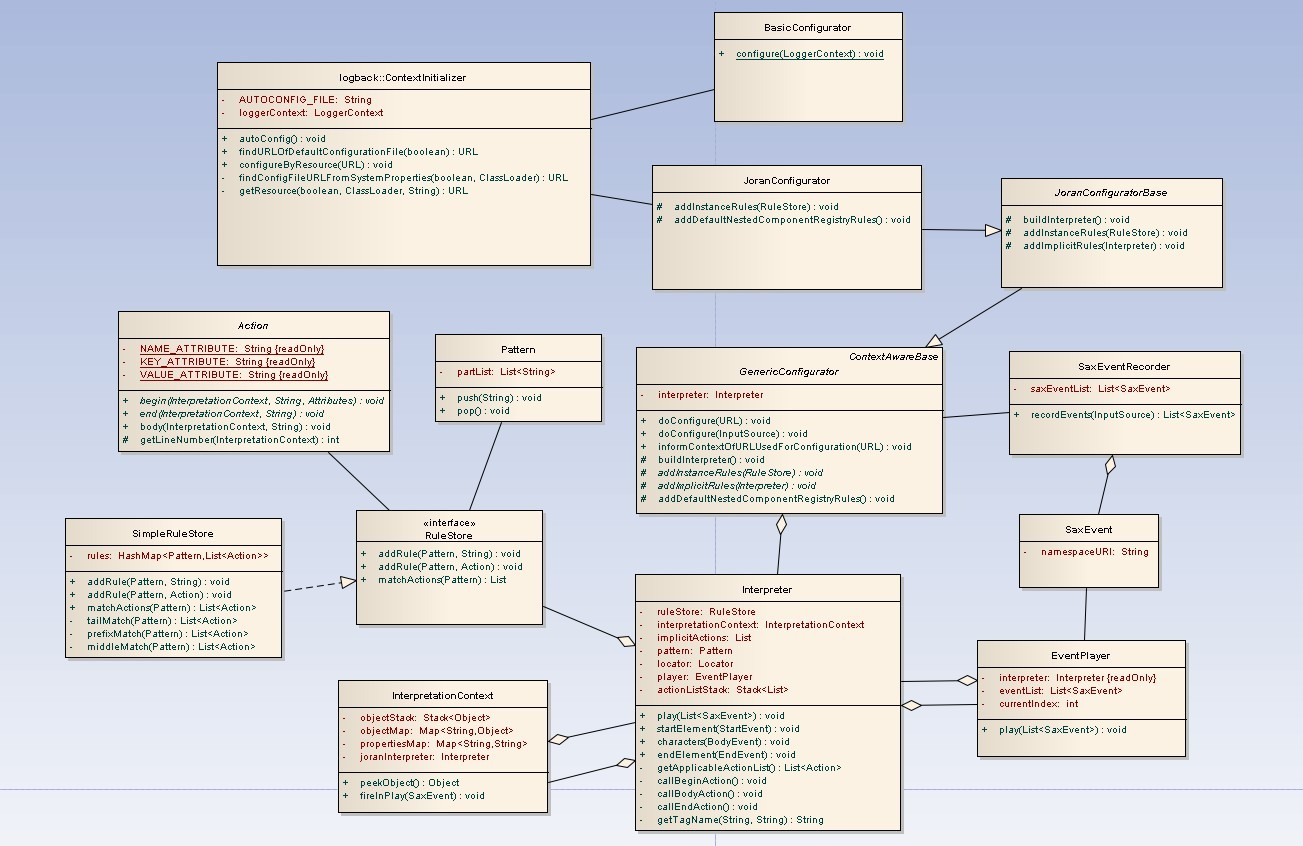这篇博客我们接着上一篇的主题,来介绍一下logback是怎么读取配置文件并初始化整个框架的。还是老规矩,先上总览图

从图中可以看到,logback框架的初始化是由ContextInitializer类来负责完成的,而实际进行配置的是GenericConfigurator类,它调用SaxEventRecorder类来负责读取logback.xml文件,然后由Interpreter类来进行解析,而最后真正的初始化工作,是由一系列Action组件来完成。接下来就实际看看代码
try { new ContextInitializer(defaultLoggerContext).autoConfig(); } catch (JoranException je) { Util.report("Failed to auto configure default logger context", je); }
以上代码来自StaticLoggerBinder类,它在提供LoggerContext之前,就对LoggerContext进行初始化,初始化的入口方法,即是ContextInitializer类的autoConfig()方法
public void autoConfig() throws JoranException { StatusListenerConfigHelper.installIfAsked(loggerContext); URL url = findURLOfDefaultConfigurationFile(true); if (url != null) { configureByResource(url); } else { Configurator c = EnvUtil.loadFromServiceLoader(Configurator.class); if (c != null) { try { c.setContext(loggerContext); c.configure(loggerContext); } catch (Exception e) { throw new LogbackException(String.format("Failed to initialize Configurator: %s using ServiceLoader", c != null ? c.getClass() .getCanonicalName() : "null"), e); } } else { BasicConfigurator basicConfigurator = new BasicConfigurator(); basicConfigurator.setContext(loggerContext); basicConfigurator.configure(loggerContext); } } }
这里首先调用findURLOfDefaultConfigurationFile()方法,来寻找一个配置文件,一般就是logback.xml文件,
如果找到了,就调用configureByResource()方法,根据配置文件进行配置
如果没有找到,再去查找本地的 Configurator.class 配置类配置
如果没有找到,则用BasicConfigurator来进行默认配置
public void configureByResource(URL url) throws JoranException { if (url == null) { throw new IllegalArgumentException("URL argument cannot be null"); } final String urlString = url.toString(); if (urlString.endsWith("groovy")) { if (EnvUtil.isGroovyAvailable()) { // avoid directly referring to GafferConfigurator so as to avoid // loading groovy.lang.GroovyObject . See also http://jira.qos.ch/browse/LBCLASSIC-214 GafferUtil.runGafferConfiguratorOn(loggerContext, this, url); } else { StatusManager sm = loggerContext.getStatusManager(); sm.add(new ErrorStatus("Groovy classes are not available on the class path. ABORTING INITIALIZATION.", loggerContext)); } } else if (urlString.endsWith("xml")) { JoranConfigurator configurator = new JoranConfigurator(); configurator.setContext(loggerContext); configurator.doConfigure(url); } else { throw new LogbackException("Unexpected filename extension of file [" + url.toString() + "]. Should be either .groovy or .xml"); } }
这里如果配置文件是以.groovy结尾,就调用另一种方法进行配置,我没有跟进去看;如果是常规以.xml文件结尾,那么就用JoranConfigurator类来进行配置
public final void doConfigure(URL url) throws JoranException { InputStream in = null; try { informContextOfURLUsedForConfiguration(getContext(), url); URLConnection urlConnection = url.openConnection(); // per http://jira.qos.ch/browse/LBCORE-105 // per http://jira.qos.ch/browse/LBCORE-127 urlConnection.setUseCaches(false); in = urlConnection.getInputStream(); doConfigure(in, url.toExternalForm()); } catch (IOException ioe) { String errMsg = "Could not open URL [" + url + "]."; addError(errMsg, ioe); throw new JoranException(errMsg, ioe); } finally { if (in != null) { try { in.close(); } catch (IOException ioe) { String errMsg = "Could not close input stream"; addError(errMsg, ioe); throw new JoranException(errMsg, ioe); } } } }
这个方法则是打开配置文件的URL,转化成InputStream,然后继续调用
public final void doConfigure(InputStream inputStream, String systemId) throws JoranException { InputSource inputSource = new InputSource(inputStream); inputSource.setSystemId(systemId); doConfigure(inputSource); }
又调用了下面的方法:
// 这是 doConfigure 的最内部形式,其他 doConfigure 方法最终委托给它 public final void doConfigure(final InputSource inputSource) throws JoranException { long threshold = System.currentTimeMillis(); // if (!ConfigurationWatchListUtil.wasConfigurationWatchListReset(context)) { // informContextOfURLUsedForConfiguration(getContext(), null); // } SaxEventRecorder recorder = new SaxEventRecorder(context); recorder.recordEvents(inputSource); doConfigure(recorder.saxEventList); // no exceptions a this level StatusUtil statusUtil = new StatusUtil(context); if (statusUtil.noXMLParsingErrorsOccurred(threshold)) { addInfo("Registering current configuration as safe fallback point"); registerSafeConfiguration(recorder.saxEventList); } }
接下来创建一个SaxEventRecorder类,由它负责读取XML文件,并解析成流,创建SaxEvent这部分功能是JDK提供的。
然后调用 doConfigure 方法,再调用是一个核心方法buildInterpreter()
public void doConfigure(final List<SaxEvent> eventList) throws JoranException { buildInterpreter(); // disallow simultaneous configurations of the same context synchronized (context.getConfigurationLock()) { interpreter.getEventPlayer().play(eventList); } }
protected void buildInterpreter() { RuleStore rs = new SimpleRuleStore(context); addInstanceRules(rs); this.interpreter = new Interpreter(context, rs, initialElementPath()); InterpretationContext interpretationContext = interpreter.getInterpretationContext(); interpretationContext.setContext(context); addImplicitRules(interpreter); addDefaultNestedComponentRegistryRules(interpretationContext.getDefaultNestedComponentRegistry()); }
这里的核心是初始化了interpreter字段,
Interpreter在框架的配置中是一个很关键的类,logback是依赖这个类来进行初始化工作的。这里用到了RuleStore接口,RuleStore只有一个唯一的实现类SimpleRuleStore,这个类的作用是,把Pattern匹配到Action上,因为所有的配置工作,最终是由Action来完成的。作者对这个类的设计是十分精巧的,个人认为logback框架的初始化设计思路,是非常值得学习的,这部分内容也是我阅读logback源码感觉收获最大的地方
buildInterpreter()方法调用之后,调用play(recorder.saxEventList)方法,开始进行配置。注意,这个时候logback.xml文件已经被解析成了SAX流,并且保存在SaxEventRecorder的saxEventList字段里了。
接下来就要重点分析一下Interpreter这个核心类的字段和方法,一些不重要和一目了然的字段和方法,这里就忽略了
public class Interpreter { private static List<Action> EMPTY_LIST = new Vector<Action>(0); final private RuleStore ruleStore; final private InterpretationContext interpretationContext; final private ArrayList<ImplicitAction> implicitActions; final private CAI_WithLocatorSupport cai; private ElementPath elementPath; Locator locator; EventPlayer eventPlayer;
以上的字段中,
ruleStore正如前面提到的,是用来根据Sax节点,来匹配对应的Action。ruleStore是在Interpreter创建时初始化的,而且只初始化一次,因此logback.xml中的每个元素,用哪个Action来处理,都已经规定好了。如果在解析logback.xml的过程中,遇到了无法识别的元素,就会抛出异常
interpretationContext 也非常关键,在Action组件实际处理过程中,大部分对象的出栈和入栈,都依赖这个类来实现
pattern 存放了当前正在处理的元素
介绍完了关键的字段,接下来看方法,委托EventPlayer来处理SAX流
public void play(List<SaxEvent> aSaxEventList) { eventList = aSaxEventList; SaxEvent se; for (currentIndex = 0; currentIndex < eventList.size(); currentIndex++) { se = eventList.get(currentIndex); if (se instanceof StartEvent) { interpreter.startElement((StartEvent) se); // invoke fireInPlay after startElement processing interpreter.getInterpretationContext().fireInPlay(se); } if (se instanceof BodyEvent) { // invoke fireInPlay before characters processing interpreter.getInterpretationContext().fireInPlay(se); interpreter.characters((BodyEvent) se); } if (se instanceof EndEvent) { // invoke fireInPlay before endElement processing interpreter.getInterpretationContext().fireInPlay(se); interpreter.endElement((EndEvent) se); } } }
这个方法是对整个logback.xml配置文件的元素来循环遍历,并根据SaxEvent的类型,还给Interpreter类来处理,SaxEvent有3种,基本大同小异,我们用StartEvent来举例
public void startElement(StartEvent se) { setDocumentLocator(se.getLocator()); startElement(se.namespaceURI, se.localName, se.qName, se.attributes); }
这里设置了一下文档的Locator,然后继续调用
private void startElement(String namespaceURI, String localName, String qName, Attributes atts) { String tagName = getTagName(localName, qName); elementPath.push(tagName); if (skip != null) { // every startElement pushes an action list pushEmptyActionList(); return; } List<Action> applicableActionList = getApplicableActionList(elementPath, atts); if (applicableActionList != null) { actionListStack.add(applicableActionList); callBeginAction(applicableActionList, tagName, atts); } else { // every startElement pushes an action list pushEmptyActionList(); String errMsg = "no applicable action for [" + tagName + "], current ElementPath is [" + elementPath + "]"; cai.addError(errMsg); } }
这个方法先得到元素的TagName,然后通过RuleStore来匹配一下,得到处理的Action列表,然后调用callBeginAction()方法来处理,如果SaxEvent类型是EndEvent,则这里是调用callEndAction()方法
void callBeginAction(List<Action> applicableActionList, String tagName, Attributes atts) { if (applicableActionList == null) { return; } Iterator<Action> i = applicableActionList.iterator(); while (i.hasNext()) { Action action = (Action) i.next(); // now let us invoke the action. We catch and report any eventual // exceptions try { action.begin(interpretationContext, tagName, atts); } catch (ActionException e) { skip = elementPath.duplicate(); cai.addError("ActionException in Action for tag [" + tagName + "]", e); } catch (RuntimeException e) { skip = elementPath.duplicate(); cai.addError("RuntimeException in Action for tag [" + tagName + "]", e); } } }
1、首先读取配置文件,如果没有找到配置文件,则用默认配置
2、如果找到配置文件logback.xml,则调用SAX解析器来解析该配置文件
3、初始化一个Interpreter对象,调用其play()方法
4、Interpreter对象委托EventPlayer对象,循环遍历XML文件中的所有节点
5、根据节点的类型(<element>、</element>、content),调用Interpreter中的startElement()、characters()、endElement()方法
6、Interpreter委托RuleStore来匹配元素名,选择合适的Action
7、委托Action组件来进行实际的配置
本篇博客的内容就结束了,把logback框架是怎么配置的讲了一半,但Action组件是怎么进行实际配置的,暂时没有涉及,下一篇博客就介绍这个方面的内容
博客来源:
由于使用的版本较高,本文稍有不同,新版本中也见到很多新的编程思想
